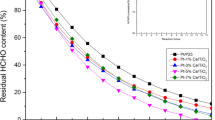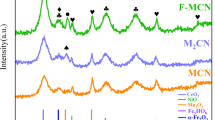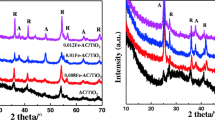Abstract
The complete decomposition of formaldehyde (HCHO) at ambient temperature is the most potential strategy for HCHO elimination from indoor environment. Herein, extra low content of Pt nanoparticles (0.025 wt%) supported on water-solubility carbon nitride/ceria (Pt/g-C3N4@CeO2) was prepared for gaseous HCHO removal at ambient temperature in a simulated indoor environment. Fluorescent light (8 W) illumination could visibly boost the complete decomposition of HCHO into CO2 over Pt/g-C3N4@CeO2. The cooperative effect in the distinct heterostructure and plenty of surface reactive oxygen species contribute primarily to the enhanced catalytic performance of Pt/g-C3N4@CeO2. Moreover, the possible mechanism of HCHO oxidation over Pt/g-C3N4@CeO2 assisted by the fluorescent light irradiation was proposed based on the physicochemical and optical characterization as well as the result of in situ diffuse reflectance infrared Fourier transform spectra. This work might shed some light on the potential application of the versatile catalysts for ambient-temperature catalytic decomposition of HCHO by making full use of the indoor energies.
Graphic Abstract

Chinese Abstract
室温催化氧化甲醛 (HCHO) 是去除室内环境中 HCHO 最有潜力的方法. 本工作将制备的水溶性氮化碳/氧化铈负载超低含量铂 (0.025 wt%) 复合催化剂 (Pt/g-C3N4@CeO2) 用于模拟室内环境中HCHO的去除. 结果发现, 荧光灯 (8 W) 照射可明显促进 HCHO 在 Pt/g C3N4@CeO2 上完全分解为 CO2 和 H2O. Pt/g-C3N4@CeO2 催化性能的增强主要得益于其独特的异质结结构和丰富的表面活性氧物种间的协同作用. 根据催化剂的理化性质和光学性能表征及原位红外漫反射光谱结果, 提出了荧光灯辅助增强 Pt/g-C3N4@CeO2 催化氧化甲醛的可能机理. 这项工作为充分利用室内能源, 开发具有应用前景的室温催化分解 HCHO 的多功能催化剂提供了思路.









Similar content being viewed by others
References
Jiang CJ, Li DD, Zhang PY, Li JG, Wang J, Yu JG. Formaldehyde and volatile organic compound (VOC) emissions from particleboard: identification of odorous compounds and effects of heat treatment. Build Environ. 2017;117(15):118.
Setvin M, Hulva J, Wang HH, Simschitz T, Schmid M, Parkinson GS, Valentin CD, Selloni A, Diebold U. Formaldehyde adsorption on the anatase TiO2(101) surface: experimental and theoretical investigation. J Phys Chem C. 2017;121(16):8914.
Xu ZH, Yu JG, Low JX, Jaroniec M. Microemulsion-assisted synthesis of mesoporous aluminum oxyhydroxide nanoflakes for efficient removal of gaseous formaldehyde. ACS Appl Mater Inter. 2014;6(3):2111.
Song SQ, Lu CH, Wu X, Jiang SJ, Sun CZ, Le ZG. Strong base g-C3N4 with perfect structure for photocatalytically eliminating formaldehyde under visible-light irradiation. Appl Catal B. 2018;227:145.
Zhang GX, Sun ZM, Duan YW, Ma RX, Zheng SL. Synthesis of nano-TiO2/diatomite composite and its photocatalytic degradation of gaseous formaldehyde. Appl Surf Sci. 2017;412:105.
Lu SH, Kl Li, Huang FL, Chen CC, Sun B. Efficient MnOx-Co3O4-CeO2 catalysts for formaldehyde elimination. Appl Surf Sci. 2017;400:277.
Huang YC, Long B, Tang MN, Rui ZB, Balogun MS, Tong YX, Ji HB. Bifunctional catalytic material: an ultrastable and high-performance surface defect CeO2 nanosheets for formaldehyde thermal oxidation and photocatalytic oxidation. Appl Catal B. 2016;181:779.
Ye JW, Yu Y, Fan JJ, Cheng B, Yu JG, Ho WK. Room-temperature formaldehyde catalytic. Environ Sci-Nano. 2020;7(12):3655.
Li Q, Yan ZX, Wang NH, Xu ZH, Wang GM, Huang G. 0D/2D CeO2 quantum dot/NiO nanoplate supported an ultralow-content Pt catalyst for the efficient oxidation of formaldehyde at room temperature. Catal Sci Technol. 2020;10(12):4030.
Huang G, Yan ZX, Liu SY, Luo TT, An L, Xu ZH. Bimetallic nickel molybdate supported Pt catalyst for efficient removal of formaldehyde at low temperature. J Environ Sci. 2020;87(1):173.
Wang NH, Xu ZH, Luo TT, Yan ZX, Jin M, Shi L. Pt anchored on Mn(Co)CO3/MnCo2O4 heterostructure for complete oxidation of formaldehyde at room temperature. ChemistrySelect. 2020;5(34):10537.
Zhu XB, Gao X, Qin R, Zeng YX, Qu RY, Zheng CH, Tu X. Plasma-catalytic removal of formaldehyde over Cu–Ce catalysts in a dielectric barrier discharge reactor. Appl Catal B. 2015;170–171:293.
Xu ZJ, Hou HP. Formaldehyde removal from air by a biodegradation system. B Environ Contam Tox. 2010;85(1):28.
Nie LH, Zhou P, Yu JG, Jaroniec M. Deactivation and regeneration of Pt/TiO2 nanosheet-type catalysts with exposed (001) facets for room temperature oxidation of formaldehyde. J Mol Catal A: Chem. 2014;390:7.
Xu ZH, Yu JG, Jaroniec M. Efficient catalytic removal of formaldehyde at room temperature using AlOOH nanoflakes with deposited Pt. Appl Catal B. 2015;163:306.
Yan ZX, Xu ZH, Yu JG, Jaroniec M. Enhanced formaldehyde oxidation on CeO2/AlOOH-supported Pt catalyst at room temperature. Appl Catal B. 2016;199:458.
Li K, Ji J, Huang HB, He M. Efficient activation of Pd/CeO2 catalyst by non-thermal plasma for complete oxidation of indoor formaldehyde at room temperature. Chemosphere. 2020;246:125762.
Jia ML, Bai HF, Zhaorigetu, Shen YN, Li YF. Preparation of Au/CeO2 catalyst and its catalytic performance for HCHO oxidation. J Rare Earth. 2008;26(4):528.
Yan ZX, Xu ZH, Yu JG, Jaroniec M. Effect of microstructure and surface hydroxyls on the catalytic activity of Au/AlOOH for formaldehyde removal at room temperature. J Colloid Interf Sci. 2017;501:164.
Wang XY, Rui ZB, Ji HB. DFT study of formaldehyde oxidation on silver cluster by active oxygen and hydroxyl groups: mechanism comparison and synergistic effect. Catal Today. 2020;347:124.
Liu F, Shen J, Xu DF, Zhou WY, Zhang SY, Wan L. Oxygen vacancies enhanced HCHO oxidation on a novel NaInO2 supported Pt catalyst at room temperature. Chem Eng J. 2018;334(2):2283.
Chen Y, Murakami N, Chen HY, Sun J, Zhang QT, Wang ZF, Ohno T, Zhang M. Improvement of photocatalytic activity of high specific surface area graphitic carbon nitride by loading a co-catalyst. Rare Met. 2019;38(5):468.
Liu SH, Lin WX. A simple method to prepare g-C3N4-TiO2/waste zeolites as visible-light-responsive photocatalytic coatings for degradation of indoor formaldehyde. J Hazard Mater. 2019;368:468.
Yin LS, Yuan YP, Cao SW, Zhang ZY, Xue C. Enhanced visible-light-driven photocatalytic hydrogen generation over g-C3N4 through loading the noble metal-free NiS2 cocatalyst. RSC Adv. 2014;4(12):6127.
Deonikar VG, Reddy KK, Chung WJ, Kim H. Facile synthesis of Ag3PO4/g-C3N4 composites in various solvent systems with tuned morphologies and their efficient photocatalytic activity for multi-dye degradation. J Photoch Photobio A. 2019;368:168.
Wang ZT, Xu JL, Zhou H, Zhang X. Facile synthesized of Zn(II)-doped g-C3N4 and their enhanced photocatalytic activity under visible light irradiation. Rare Met. 2019;38(5):459.
Ali W, Zhang XL, Zhang XX, Ali S, Zhao LN, Shaheen S. Improved visible-light activities of g-C3N4 nanosheets by co-modifying nano-sized SnO2 and Ag for CO2 reduction and 2,4-dichlorophenol degradation. Mater Res Bull. 2020;122:110676.
He QC, Zhou F, Zhan S, Huang NB, Tian Y. Photoassisted oxygen reduction reaction on mpg-C3N4: the effects of elements doping on the performance of ORR. Appl Surf Sci. 2018;430:325.
Fu JW, Xu QL, Low JX, Jiang CJ, Yu JG. Ultrathin 2D/2D WO3/g-C3N4 step-scheme H2-production photocatalyst. Appl Catal B. 2019;243:556.
Wang L, Zhu CL, Yin LS, Huang W. Constructure of Pt-M (M = Co, Ni, Fe)/g-C3N4 composites for highly efficient photocatalytic H2 generation. Acta Phys-Chim Sin. 2020;36(7):1907001.
Yu HJ, Shi R, Zhao YX, Bian T, Zhao YF, Zhou C, Geoffrey INW, Wu LZ, Tung CH, Zhang TR. Alkali-assisted synthesis of nitrogen deficient graphitic carbon nitride with tunable band structures for efficient visible-light-driven hydrogen evolution. Adv Mater. 2017;29(16):1605148.
Zhang YT, Shen C, Lu XM, Mu XL, Song P. Effects of defects in g-C3N4 on excited-state charge distribution and transfer: potential for improved photocatalysis. Spectrochim Acta A. 2020;227:117687.
Zhao W, Wang J, Yin R, Li BY, Huang XS, Zhao LL, Qian L. Single-atom Pt supported on holey ultrathin g-C3N4 nanosheets as efficient catalyst for Li-O2 batteries. J Colloid Interf Sci. 2020;564:28.
Zhang LJ, Hao XQ, Li YB, Jin ZL. Performance of WO3/g-C3N4 heterojunction composite boosting with NiS for photocatalytic hydrogen evolution. Appl Surf Sci. 2020;499:143862.
Zhang P, Zhang LX, Xu H, Xing Y, Chen JJ, Bie LJ. Ultrathin CeO2 nanosheets as bifunctional sensing materials for humidity and formaldehyde detection. Rare Met. 2019;38(5):459.
Pastor-Pérez L, Ramos-Fernández EV, Sepúlveda-Escribano A. Effect of the CeO2 synthesis method on the behaviour of Pt/CeO2 catalysis for the water-gas shift reaction. Int J Hydrogen Energ. 2019;44(39):21837.
Yang SQ, Zhou F, Liu YJ, Zhang L, Chen Y, Wang HH, Tian Y, Zhang CS, Liu DS. Morphology effect of ceria on the performance of CuO/CeO2 catalysts for hydrogen production by methanol steam reforming. Int J Hydrogen Energ. 2019;44(14):7252.
Chen DD, Ma QH, Wei LF, Li NX, Shen QH, Tian W, Zhou JC, Long JY. Catalytic hydroliquefaction of rice straw for bio-oil production using Ni/CeO2 catalysts. J Anal Appl Pyrol. 2018;130:169.
Nithya R, Ayyappan S. Novel exfoliated graphitic-C3N4 hybridised ZnBi2O4 (g-C3N4/ZnBi2O4) nanorods for catalytic reduction of 4-nitrophenol and its antibacterial activity. J Photoch Photobio A. 2020;398:112591.
Wang HY, Yang WP, Wang XX, Huang LN, Zhang YY, Yao SZ. A CeO2@MnO2 core–shell hollow heterojunction as glucose oxidase-like photoenzyme for photoelectrochemical sensing of glucose. Sensor Actuat B-Chem. 2020;304:127389.
Zheng Y, Liu J, Liang J, Jaroniec M, Qiao SZ. Graphitic carbon nitride materials: controllable synthesis and applications in fuel cells and photocatalysis. Energ Environ Sci. 2012;5(5):6717.
Mokkelbost T, Kaus I, Grande T, Einarsrud MA. Combustion synthesis and characterization of nanocrystalline CeO2-based powders. Chem Mater. 2004;16(25):5489.
Binet C, Daturi M, Lavalley JC. IR study of polycrystalline ceria properties in oxidised and reduced states. Catal Today. 1999;50(2):207.
Ansari S, Ansari MS, Dev N, Satsangee SP. CeO2 nanoparticles based electrochemical sensor for an anti-anginal drug. Mater Today: Proceedings. 2019;18:1210.
Lu XH, Huang X, Xie SL, Zheng DZ, Liu ZQ, Liang CL, Tong YX. Facile electrochemical synthesis of single crystalline CeO2 octahedrons and their optical properties. Langmuir. 2010;26(10):7569.
Li H, Jing Y, Ma XL, Liu TY, Yang LF, Liu B, Yin S, Wei YZ, Wang YH. Construction of a well-dispersed Ag/graphene-like g-C3N4 photocatalyst and enhanced visible light photocatalytic activity. RSC Adv. 2017;7(14):8688.
Tan LH, Xu JH, Zhang XJ, Hang ZS, Jia YQ, Wang SB. Synthesis of g-C3N4/CeO2 nanocomposites with improved catalytic activity on the thermal decomposition of ammonium perchlorate. Appl Surf Sci. 2015;356:447.
Zhang LJ, Su ZX, Jiang FL, Yang LL, Qian JL, Zhou YF, Li WM, Hong MC. Highly graphitized nitrogen-doped porous carbon nanopolyhedra derived from ZIF-8 nanocrystals as efficient electrocatalysts for oxygen reduction reactions. Nanoscale. 2014;6(12):6590.
Li ML, Zhang LX, Wu MY, Du YY, Fan XQ, Wang M, Zhang LL, Kong QL, Shi JL. Mesostructured CeO2/g-C3N4 nanocomposites: remarkably enhanced photocatalytic activity for CO2 reduction by mutual component activations. Nano Energy. 2016;19:145.
Zou WX, Deng B, Hu XX, Zhou YP, Pu Y, Yu SH, Ma KL, Sun JF, Wan HQ, Dong L. Crystal-plane-dependent metal oxide-support interaction in CeO2/g-C3N4 for photocatalytic hydrogen evolution. Appl Catal B. 2018;238:111.
Zang CJ, Zhang XS, Hu SY, Chen F. The role of exposed facets in the Fenton-like reactivity of CeO2 nanocrystal to the Orange II. Appl Catal B. 2017;216:106.
Ge L, Han CC, Liu J. Novel visible light-induced g-C3N4/Bi2WO6 composite photocatalysts for efficient degradation of methyl orange. Appl Catal B. 2011;108–109:100.
Zhang GJ, Zheng HM, Shen M, Wang L, Wang XS. Green synthesis and characterization of Au@Pt core–shell bimetallic nanoparticles using gallic acid. J Phys Chem Solids. 2015;81:79.
Huang YC, Wu SH, Hsiao CH, Lee AT, Huang MH. Mild synthesized of size tunable CeO2 octahedra for band gap variation. Chem Mater. 2020;32(6):2631.
Wang XS, Zhou C, Shi R, Liu QQ, Waterhouse GIN, Wu LZ, Tung CH, Zhang TR. Supramolecular precursor strategy for the synrthesis of holey graphitic carbon nitride nanotubes with enhanced photocatalytic hydrogen evolution performance. Nano Res. 2019;12(9):2385.
Wang M, Guo PY, Chai TY, Xie YH, Han J, You MY, Wang YZ, Zhu T. Effects of Cu dopants on the structures and photocatalytic performance of cocoon-like Cu-BiVO4 prepared via ethylene glycol solvothermal method. J Alloy Compd. 2017;691:8.
Raskó J, Kecskés T, Kiss J. Formaldehyde formation in the interaction of HCOOH with Pt supported on TiO2. J Catal. 2004;224(2):261.
Yan ZX, Xu ZH, Yang ZH, Yue L, Huang LY. Graphene oxide/Fe2O3 nanoplates supported Pt for enhanced room-temperature oxidation of formaldehyde. Appl Surf Sci. 2019;467–468:277.
Kecskés T, Raskó J, Kiss J. FTIR and mass spectrometric studies on the interaction of formaldehyde with TiO2 supported Pt and Au catalysts. Appl Catal A-Gen. 2004;273(1–2):55.
Ju P, Wang P, Li B, Fan H, Ai SY, Zhang D, Wang Y. A novel calcined Bi2WO6/BiVO4 heterojunction photocatalyst with highly enhanced photocatalytic activity. Chem Eng J. 2014;236:430.
Hu XF, Hu JS, Peng QQ, Ma XG, Dong SJ. Wang HH. Construction of 2D all-solid-state Z-scheme g-C3N4/BiOI/RGO hybrid structure immobilized on Ni foam for CO2 reduction and pollutant degradation. Mater Res Bull. 2020;122:110682.
Issarapanacheewin S, Wetchakun K, Phanichphant S, Kangwansupamonkon W, Wetchakun N. A novel CeO2/Bi2WO6 composite with highly enhanced photocatalytic activity. Mater Lett. 2015;156:28.
Zhao XX, Guan JR, Li JZ, Li X, Wang HQ, Huo PW, Yan YS. CeO2/3D g-C3N4 heterojunction with Pt cocatalyst for enhanced photocatalytic CO2 reduction. Appl Suef Sci. 2021;537:147891.
Jia Z, Yu FL, Zhang LC, Zeng S, Liang SX, Li YY, Lu J. Pt nanoparticles decorated heterostructured g-C3N4/Bi2MoO6 microplates with highly enhanced phoyocatalytic activities under visible light. Sci Rep. 2019;9(1):7636.
Acknowledgements
This work was financially supported by the National Natural Science Foundation of China (No. 21871111) and the Excellent Youth Foundation of Hubei Province of China (No. 2019CFA078).
Author information
Authors and Affiliations
Corresponding authors
Supplementary Information
Below is the link to the electronic supplementary material.
Rights and permissions
About this article
Cite this article
Huang, G., Xu, ZH., Luo, TT. et al. Fluorescent light enhanced graphitic carbon nitride/ceria with ultralow-content platinum catalyst for oxidative decomposition of formaldehyde at ambient temperature. Rare Met. 40, 3135–3146 (2021). https://doi.org/10.1007/s12598-021-01756-7
Received:
Revised:
Accepted:
Published:
Issue Date:
DOI: https://doi.org/10.1007/s12598-021-01756-7




